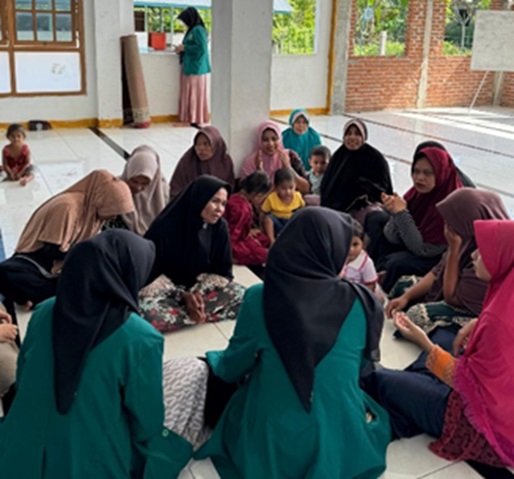Penggunaan Teknik Komunikasi Antar Personal dalam Penguatan Imunisasi
Use of Interpersonal Communication Techniques in Strengthening Immunization
DOI:
https://doi.org/10.33084/pengabdianmu.v9i12.7768Keywords:
Indonesia, Communication, Immunization, StuntingAbstract
The government in Indonesia continues to focus its attention on the problem of stunting (shortness). In 2022, the prevalence of stunting was 31.2%. Meanwhile, in Aceh Besar Regency's Atong Village, 5% of children under the age of five were stunted. Infectious disease is one of the stunting risk factors that immunization can help avoid. Therefore, the aim of executing this community service in Atong village is to raise the community's knowledge and awareness of child vaccination in the future. The method conducted was Inter-Personal Communication (KAP), which has an instructional and engaging model. The implementation employed instructive entertaining games and songs to demonstrate the efficacy of immunization and its schedule. The respondents included adults and the elderly who will support childhood immunization today and in the future. The activity lasted one day and began with an introductory game, followed by listening to one another in the form of a critical thinking stage about the types of diseases that children suffer from, a stage of finding ways to maintain children's health, a learning stage about types of immunizations, and a commitment stage to carry out routine immunizations. There were 60 persons in attendance, and all of them were quite enthusiastic about learning. The KAP approach was successful in getting people interested in learning about immunization. KAP strategies should be used in various sensitive educational settings in the community.
Downloads
References
Basu, S., Ashok, G., Debroy, R., Ramaiah, S., Livingstone, P., & Anbarasu, A. (2023, Dec 31). Impact of the COVID-19 pandemic on routine vaccine landscape: A global perspective. Hum Vaccin Immunother, 19(1), 2199656. https://doi.org/10.1080/21645515.2023.2199656
Bayih, G., Teklu, A., Mekonnen, Z. A., Tsedaw, T., Tefera, S., Feletto, M., . . . Tilahun, B. (2021). The Implementation of Social and Behavior Change Communication Intervention to Improve Immunization Demand: A qualitative study in Awabel District, Northwest Ethiopia. Ethiopian Journal of Health Development, 35(3). https://www.ajol.info/index.php/ejhd/article/view/217892
Darmin, Rumaf, F., Ningsih, S. R., Mongilong, R., Goma, M. A. D., & Anggaria, A. D. (2023, 05/11). Pentingnya Imunisasi Dasar Lengkap Pada Bayi dan Balita. Jurnal Pengabdian kepada Masyarakat MAPALUS, 1(2), 15-21. https://www.e-journal.stikesgunungmaria.ac.id/index.php/jpmm/article/view/37
Deep, I., Pasha, S. A., & Ali, S. (2021). Role of Mass Media and Interpersonal Communication in Polio Eradication Campaign. http://dx.doi.org/10.31703/gssr.2021(VI-I).56
Dilla, R., Vita, N. I., & Sahputra, D. (2024, 2024-04-24). Komunikasi Antarpribadi Kepala Dusun dalam Upaya Vaksinasi Masyarakat di Desa Tanjung Selamat Interpersonal Communication, Hamlet Head, Covid-19, Phenomenology. 2024, 6(1), 6. https://doi.org/10.31289/jipikom.v6i1.3016
Dinleyici, E. C., Borrow, R., Safadi, M. A. P., van Damme, P., & Munoz, F. M. (2021, 2021/02/01). Vaccines and routine immunization strategies during the COVID-19 pandemic. Human Vaccines & Immunotherapeutics, 17(2), 400-407. https://doi.org/10.1080/21645515.2020.1804776
Dou, K., Yang, J., Wang, L. X., & Li, J. B. (2022, Nov 30). Theory of planned behavior explains males' and females' intention to receive COVID-19 vaccines differently. Hum Vaccin Immunother, 18(5), 2086393. https://doi.org/10.1080/21645515.2022.2086393
Kemenkes RI. (2023). Cakupan Imunisasi Rutin Lengkap Kini Capai 94,9 Persen. Kementrian Kesehatan Republik Indonesia. Retrieved 10 Juli 2024 from https://sehatnegeriku.kemkes.go.id/baca/rilis-media/20230507/0142927/cakupan-imunisasi-rutin-lengkap-kini-capai-949-persen/
Li, Z., Kim, R., Vollmer, S., & Subramanian, S. V. (2020, Apr 1). Factors Associated With Child Stunting, Wasting, and Underweight in 35 Low- and Middle-Income Countries. JAMA Netw Open, 3(4), e203386. https://doi.org/10.1001/jamanetworkopen.2020.3386
Muryadi, E. I., Nasution, S. L. R., & Girsang, E. (2023). Analisis Komunikasi Kesehatan Terhadap Partisipasi Masyarakat Dalam Program Vaksin Covid-19 Di Kota Jambi Tahun 2023. An-Nadaa: Jurnal Kesehatan Masyarakat, 10(2), pp.199-204. http://dx.doi.org/10.31602/ann.v10i2.13319
Noori, N., Skrip, L. A., Oron, A. P., McCarthy, K. A., Proctor, J. L., Chabot-Couture, G., . . . Trehan, I. (2022, Oct 12). Potential Impacts of Mass Nutritional Supplementation on Measles Dynamics: A Simulation Study. Am J Trop Med Hyg, 107(4), 863-872. https://doi.org/10.4269/ajtmh.21-1083
Pelullo, C. P., Della Polla, G., Napolitano, F., Di Giuseppe, G., & Angelillo, I. F. (2020, Mar 26). Healthcare Workers' Knowledge, Attitudes, and Practices about Vaccinations: A Cross-Sectional Study in Italy. Vaccines (Basel), 8(2). https://doi.org/10.3390/vaccines8020148
Prayoga, D., & Fitri, W. (2024, 01/13). Komunikasi Interpersonal Tenaga Kesehatan Terhadap Motivasi Berobat Anak Stunting Di Kota Padang. Jurnal Niara, 16(3), 661-671. https://doi.org/10.31849/niara.v16i3.14734
Sari, & Merty Karlina. (2021). The Interpersonal Meaning on the Covid-19 Vaccination News in Indonesia: A Systemic Functional Linguistics Study. International Journal of Linguistics, Literature and Translation, 4(8), 97-102. https://doi.org/10.32996/ijllt.2021.4.8.15
Sultana, T., Moniruzzaman, M., & Dey, S. R. (2023). Knowledge, Attitudes, and Practice (KAP) Study for Reducing Invalid Vaccine Doses in Routine Immunization: A Cross-Sectional Study in Urban Slums of Bangladesh. Qeios. https://doi.org/10.32388/0sarpc
UNICEF. (2023). Data terbaru menunjukkan penurunan kepercayaan hingga 44 persen terhadap vaksinasi anak di beberapa negara selama pandemi COVID-19. UNICEF. Retrieved 2 Agustus 2024 from https://www.unicef.org/indonesia/id/siaran-pers/data-terbaru-menunjukkan-penurunan-kepercayaan-hingga-44-persen-terhadap-vaksinasi-anak
Zahra, A. A., & Husna, A. N. (2023). Sikap terhadap vaksin Covid-19: Perbedaannya menurut faktor demografis, kesehatan, dan ekonomi serta pengaruhnya pada intensi vaksinasi. . Jurnal Psikologi Sosial, 21(1), pp.62-72. https://doi.org/10.15408/sjsbs.v7i6.38678

Downloads
Published
How to Cite
Issue
Section
License
Copyright (c) 2024 Dharina Baharuddin, Nopa Arlianti, Arifah Syahirah, Riza Septiani, Wardiati Wardiati, Na’imah Na’imah

This work is licensed under a Creative Commons Attribution-ShareAlike 4.0 International License.
Authors who publish with this journal agree to the following terms:
- Any article on the copyright is retained by the author(s).
- Author grant the journal, right of first publication with the work simultaneously licensed under a Creative Commons Attribution License that allows others to share work with acknowledgment of the work authors and initial publications in this journal.
- Authors are able to enter into a separate, additional contractual arrangements for non-exclusive distribution of published articles of work (eg, post-institutional repository) or publish it in a book, with acknowledgment of its initial publication in this journal.
- Authors are permitted and encouraged to post their work online (e.g., in institutional repositories or on their websites) prior to and during the submission process, as can lead to productive exchanges, as well as earlier and greater citation of published work.
- The article and any associated published material is distributed under the Creative Commons Attribution-ShareAlike 4.0 International License










